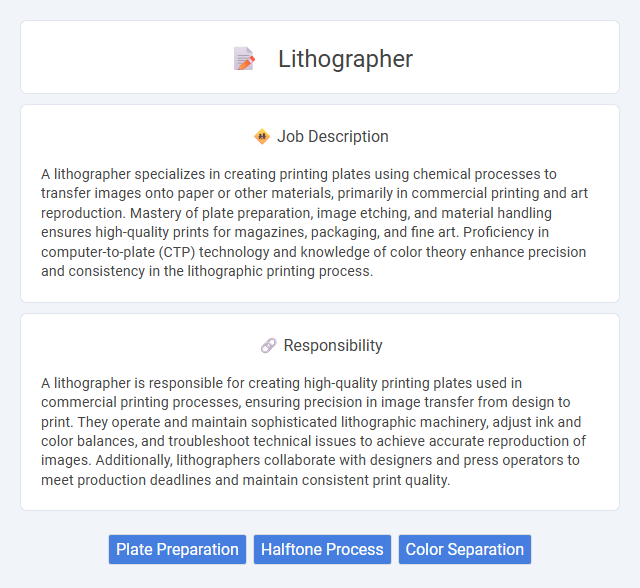
A lithographer specializes in creating printing plates using chemical processes to transfer images onto paper or other materials, primarily in commercial printing and art reproduction. Mastery of plate preparation, image etching, and material handling ensures high-quality prints for magazines, packaging, and fine art. Proficiency in computer-to-plate (CTP) technology and knowledge of color theory enhance precision and consistency in the lithographic printing process.
Individuals with strong attention to detail and steady hand coordination are likely to be well-suited for a lithographer job, as the role often requires precise handling of materials and equipment. Those who enjoy working in controlled environments and have patience for repetitive tasks may find the conditions favorable. However, people prone to stress or those who prefer dynamic, physically active roles might face challenges adapting to the lithography work environment.
Qualification
A lithographer must possess strong technical skills in operating printing presses and preparing printing plates, with proficiency in both traditional and digital lithographic techniques. Certification or formal training in graphic arts, printing technologies, or a related field enhances job prospects, alongside experience in color matching and image editing software. Attention to detail, manual dexterity, and an understanding of print production processes are critical qualifications for successful lithography.
Responsibility
A lithographer is responsible for creating high-quality printing plates used in commercial printing processes, ensuring precision in image transfer from design to print. They operate and maintain sophisticated lithographic machinery, adjust ink and color balances, and troubleshoot technical issues to achieve accurate reproduction of images. Additionally, lithographers collaborate with designers and press operators to meet production deadlines and maintain consistent print quality.
Benefit
A lithographer likely benefits from a creative work environment that supports artistic expression and technical skill development. Job stability and opportunities for advancement may be common in industries relying on high-quality printing and design. Competitive salaries and the chance to work with innovative printing technologies could further enhance job satisfaction.
Challenge
A lithographer job likely involves the challenge of precision in transferring intricate images onto surfaces, requiring keen attention to detail and steady hand coordination. Meeting tight deadlines while maintaining high-quality output may often demand strong time management and adaptability skills. Adapting to evolving printing technologies could present ongoing learning challenges that test a lithographer's technical expertise.
Career Advancement
A lithographer can advance their career by gaining expertise in advanced printing technologies and mastering digital imaging software to improve production quality and efficiency. Progression often leads to roles such as print production manager or quality control supervisor, which require strong technical skills and leadership abilities. Continuous training and certifications in graphic arts or print technology significantly enhance opportunities for promotion and specialization within the printing industry.
Key Terms
Plate Preparation
Lithographers specializing in plate preparation ensure the precise creation and treatment of printing plates, which are essential for high-quality image transfer in offset printing processes. They operate advanced machinery to etch, expose, and chemically process plates made from materials such as aluminum or polyester, optimizing them for ink adhesion and durability. Mastery of plate preparation techniques directly impacts print clarity, color accuracy, and production efficiency in commercial printing environments.
Halftone Process
A lithographer specializing in the halftone process expertly converts continuous-tone images into a series of dots to create printable artwork with varying shades and gradients. Mastery of screen angles, dot shapes, and screen rulings is essential to achieve high-quality image reproduction in newspapers, magazines, and packaging. Advanced knowledge of digital tools and traditional techniques allows lithographers to control tonal range and detail for precise halftone printing results.
Color Separation
Color separation is a crucial process in lithography that involves dividing an image into individual color components for accurate printing. Skilled lithographers utilize specialized software and techniques to ensure precise separation of cyan, magenta, yellow, and black (CMYK) layers, enhancing print quality and color fidelity. Mastery of color separation directly impacts the efficiency and visual outcome of printed materials in commercial and industrial applications.
 kuljobs.com
kuljobs.com